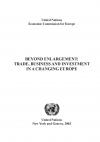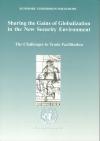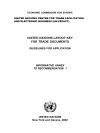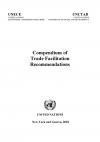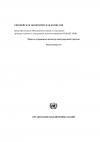Publications
Displaying Results 101 - 120 of 131
- English
Based on the presentations and contributions to the Workshop on Trade, Business and Investment in a Wider Europe on 7 April 2003 and also documents and papers relating to the topic. The publication presents to policy makers the opportunities for further economic integration within the region after the EU enlargement of 2004. It also confronts non-acceding countries with some issues that
- English
Outlines the key activities that will be undertaken in the UNECE’s traditional areas of standards development and maintenance, and new and strengthened activities in areas such as implementing trade facilitation instruments and assisting in trade policy development to address the needs of an expanded European economic space, sustainable development and ICT for development
- English
Contains contributions from representatives of UNECE, EU, WTO, WCO and the World Bank among others. The aim is to deal with the questions of how best to ensure that the rewards of global trade facilitation are shared fairly, and how to avoid reversals in the achievements of trade facilitation due to the increased security required in recent years
- English
ECE/TRADE/317: Beyond Enlargement: Trade, Business and Investment in a Changing Europe (174 pages)
- English
©2003 United NationsECE/EAD/2003/03: The Accession of Central European Countries to the European Union [pdf format -- 60 pages]
- English
Intended to offer a useful aid to all parties engaged in the creation and preparation of trade documents with the aim of continuing to reduce the cost and enhance the flow of international trade.Download : ECE/TRADE/270
- English
Intended to be used as a reference by those engaged in simplifying, harmonizing and rationalizing trade procedures and practices. It is also useful for industry, commerce, transport, administrations and organizations, to create awareness of the possibilities that exist in the area of facilitation and harmonization of trade and transport
- English
Attempts to describe briefly the most common and most severe challenges that landlocked countries face. It examines the transit issues and the legal and institutional framework and outlines the role of government. It also gives examples and illustrates by case studies how certain countries or organizations have managed to overcome certain constraint.This overview paper (TRADE/2002/23) will
- English
Presents the opportunities offered by the e-services sector and the policy issues that need to be addressed in order to create a viable enabling environment to support the shift from industrial to service sectors. It also highlights the need for a highly qualified workforce to take advantage of the new openings and aims to help potential investors to manage the risks inherent in trade in
- English
Explains what is meant by the term “Trade Facilitation”. It also briefly outlines the benefits both to governments and to the business community in terms of increased economic efficiency, better security, faster delivery of goods and reduced costs.The two chapters in Part One introduce the main issues set forth in this book. The first one, “The Policy Debate on Trade Facilitation”,
- English
Provides a comprehensive set of recommendations regarding international best practices and standards for the facilitation and harmonisation of trade transactions, from initial commercial documents to payment measures, official controls and transportation of goods. The document reflects recent changes in trade practice, as well as the ongoing changes brought about by the adoption of e-
- English
Explains what is meant by electronic commerce and addresses the issue of the convergence of business and technology and the work of the UN/CEFACT towards electronic business. It also outlines the importance of the simplification of administrative constraints and provides examples of the use of electronic commerce to improve administration
Цель данной брошюры (ECE/TRADE/415) – предоставить информацию об имеющихся бесплатных методических материалах Европейской экономической комиссии Организации Объединенных Наций (ЕЭК ООН), которые можно использовать в качестве вспомогательных материалов в проектах инициативы «Помощь в интересах торговли». Под материалами мы имеем
Европейская экономическая комиссия ООН (ЕЭК ООН) имеет давнюю традицию предоставления руководств по упрощению процедур торговли, особенно на тему «Единого окна». С момента своего появления в 2004 году, Рекомендация № 33 о внедрении «Единого окна», была широко принята в качестве ориентира по данному вопросу. Она используется как основа для работы многих других организаций, а также берется за
La Commission économique pour l'Europe (CEE) propose depuis longtemps des orientations en matière de facilitation des échanges, en particulier sur le guichet unique. Depuis son apparition en 2004, la Recommandation 33 sur la mise en place d'un guichet unique a été largement perçue comme référence sur le sujet et sert de base au travail de nombreuses autres organisations ainsi qu'à la pierre
La Recommandation 42 sur les mécanismes de surveillance du commerce et de la facilitation du transport aborde les questions liées aux arrangements institutionnels et à la méthodologie dans la conception et la mise en oeuvre de ces mécanismes. C'est une contribution importante à la série de recommandations de la CEE sur la facilitation des échanges et aux documents d'orientation.
В Рекомендации № 42 о создании механизма мониторинга упрощения процедур торговли и транспорта (ММУПТТ) рассматриваются вопросы, связанные с институциональными механизмами и методологией в разработке и внедрении ММУПТТ. Это важный вклад в набор рекомендаций и инструктивного материала ЕЭК ООН по упрощению процедур торговли.ECE/
Цель настоящего Глоссария - представить полный перечень терминов по надзору за рынком, используемых в законодательной практике (термины приведены на английском, французском и русском языках). Скачать публикацию (ECE/TRADE/389
Le présent glossaire trilingue s'attache à apporter une liste exhaustive des termes employés en anglais, français et russe dans la pratique législative liée à la surveillance des marchés. Télécharge: ECE/TRADE/389
Introduction Au cours des dernières années, la facilitation du commerce a été reconnue comme un facteur essentiel de la politique commerciale et de développement économique, ce qui s’explique par le constat selon lequel la facilitation du commerce peut apporter des avantages appréciables pour l’économie en termes de compétitivité et d’efficacité, et nettement


